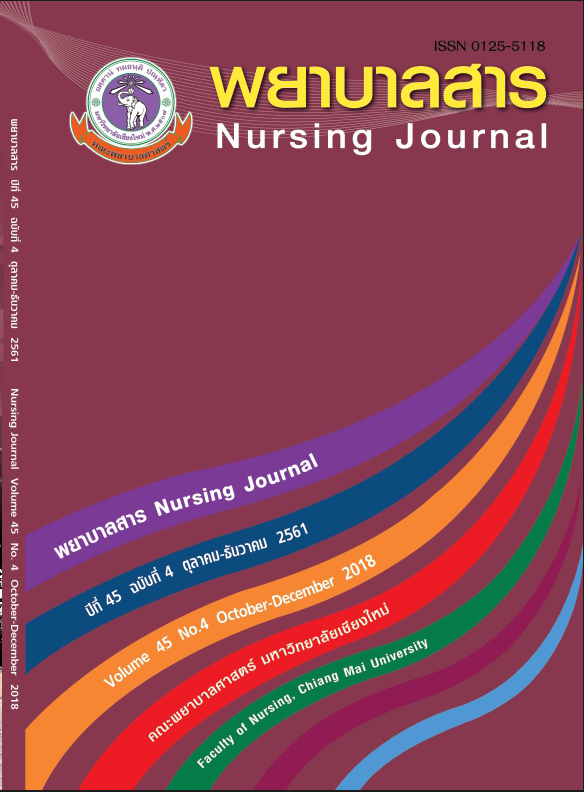การพยาบาลเด็กที่มีภาวะไม่สมดุลของอิเล็กโทรไลต์
คำสำคัญ:
การดูแลเด็กที่มีภาวะไม่สมดุลของอิเล็กโทรไลต์, บทบาทพยาบาลบทคัดย่อ
ภาวะไม่สมดุลของอิเล็กโทรไลต์เกิดขึ้นได้บ่อยในเด็กป่วยที่เข้ารับการรักษาในโรงพยาบาล ซึ่งภาวะโซเดียมในเลือดต่ำและภาวะโปแทสเซียมในเลือดต่ำเป็นภาวะไม่สมดุลของอิเล็กโทรไลต์ที่พบบ่อยมากและเป็นสาเหตุที่นำไปสู่การเจ็บป่วยและเสียชีวิตจากการเกิดภาวะแทรกซ้อน โดยเฉพาะภาวะแทรกซ้อนทางระบบประสาทและระบบการไหลเวียนโลหิต การดูแลเด็กที่มีภาวะโซเดียมในเลือดต่ำและภาวะโปแทสเซียมในเลือดต่ำเป็นบทบาทสำคัญของพยาบาลในการประเมินติดตามอาการของภาวะแทรกซ้อนที่อาจเกิดขึ้นและประสิทธิผลการรักษาของแพทย์อย่างต่อเนื่อง บทความนี้มีวัตถุประสงค์เพื่อให้พยาบาลมีความรู้ความเข้าใจเกี่ยวกับภาวะโซเดียมในเลือดต่ำและภาวะโปแทสเซียมในเลือดต่ำในเด็กป่วยในประเด็นสำคัญเรื่อง อุบัติการณ์ สาเหตุ อาการทางคลินิก การรักษา และการพยาบาล เพื่อนำมาวางแผนการดูแลเด็กที่มีภาวะโซเดียมในเลือดต่ำหรือภาวะโปแทสเซียมในเลือดต่ำได้อย่างเหมาะสม
References
Bellomo, R., Martensson, J., & Eastwood, G. M. (2015). Metabolic and electrolyte disturbance after cardiac arrest: how to deal with it. Best Practice and Research Clinical Anaesthesiology, 29, 471-484.
Bibi, S., Bibi, S., Gilani, S. Y. H., Shah, S. R. A., Haq, A., & Billo, A.G. (2015). Frequency of hospital acquired hyponatremia in a pediatric tertiary care setting. Journal of Ayub Medical College Abbottabad, 27(3), 560-563.
Burns, R. A. & Kaplan, R. L. (2014). Renal and electrolyte emergencies. In K. N. Shaw, & R. G. Bachur (Eds.), Pediatric emergency medicine (7th ed.) (pp. 997-1021). Philadelphia: Wolters Kluwer.
Chaitra, K. M., Kumar, M., & Saipraneeth, R. G. (2016). Hyponatremia in lower respiratory tract infections. International Journal of Contemporary Pediatrics, 3(2), 381-384.
Chung, C. H., & Zimmerman, D. (2009). Hyponatremia and hypernatremia: Current understanding and management. Clinical Pediatric Emergency Medicine. 10(4), 272-278.
Corbett, A. H., Dana, W. J., Fuller, M. A., Gallagher, J. C., Golembiewski, J. A., & Gonzles, J. P., et al. (2014-2015). Drug information handbook (23th ed.). USA: Wolters Kluwer.
Daly, K., & Farrington, E. (2013). Hypokalemia and hyperkalemia in infants and children: Pathophysiology and treatment. Journal of Pediatric Health Care, 27(6), 486-496.
Dastidar, R. G. & Konar, N. (2017). A study of electrolyte disturbances in a child presenting with acute gastroenteritis, with special emphasis on hyponatremic dehydration: A hospital based cross-sectional study. Pediatrics & Therapeutics, 7(2), 1-4.
Dimke, H., Monnens, L., & Hoenderop, J. G. J. (2015). Evaluation of hypomagnesemia: Lessons from disorders of tubular transport. American Journal of Kidney Diseases, 62(2), 377-383.
Greenberg, J. H., Tufro, A., & Marsenic, O. (2015). Approach to the treatment of the infant with hyponatremia. American Journal of Kidney Diseases, 65(3), 513-517.
Hockenberry, M. J. & Wilson, D. (2009). Wong’s essentials of pediatric nursing (8th ed.). St. Louis: Mosby Elsevier.
Hockenberry, M., Wilson, D., & Rodgers, C. (2017). Wong’s essentials of pediatric nursing (10th ed.). St. Louis: Mosby Elsevier.
James, S. R., & Ashwill, J. (2007). Nursing care of children: Principles & practice (3rd ed.). St. Louis: Saunders Elsevier.
Jayakumar, B., & Sambasivam, E. (2017). Clinical profile, etiology, management and outcome of serum sodium disturbances in children admitted in PICU. International Journal of Research in Medical Science, 5(6). 2546-2551.
Katavetin, P., & Tiranathanagul, K. (2017). Disorders of water balance: Hyponatremia and
hypernatremia. In P. Khotchaseni, K. Kiattisunthorn, P. Kingwatanakul, V. Ophascharoensuk
(Eds.), Fluid, electrolyte and acid-base disorders (1st ed.) (pp. 27-43). Bangkok: Text and Journal
Publication Co Ltd. (In Thai).
Kwancharoen, R. (2017). SIADH and cerebral salt wasting. In C. Deerochanawong (Ed.), Endocrinology
in clinical practice (1st ed.) (pp. 81-103). Bangkok: Ruenkaew Printing. (In Thai).
Lander, A. (2016). Update guidelines management of fluid and electrolytes in children. Surgery, 34(5), 213-216.
Lumpaopong, A. (2017). Sodium disorders: Pediatric aspect. In P. Khotchaseni, K. Kiattisunthorn,
P. Kingwatanakul, V. Ophascharoensuk (Eds.), Fluid, electrolyte and acid-base disorders (1st
ed.) (pp. 319-327). Bangkok: Text and Journal Publication Co Ltd. (In Thai).
Liamis, G, Milionis, H. J., & Elisaf, M. (2011). Hyponatremia in patients with infectious disease. Journal of Infection, 63, 327-335.
Ndirangu, E. N. (2009) Prevalence of hyponatremia in children admitted at Kenyatta national hospital with pneumonia. (Unpublished master’s thesis). University of Nairobi, Kenya.
North of England Cancer Network. (2016). NECN guidelines for management of extravasation. Retrieved from http://www.necn.nhs.uk/wp-content/uploads/2012/11/NECN-Guidelines-for-Management-of-Extravasation-v5.5-Nov-2016.pdf
Omer, R., Masood, M. K., Ashar, S., Jawad, M., Afzal, A., & Khan, H. I. (2017). Dysnatremias; Dysnatremias in pediatric critical care, etiology, epidemiology and effect on outcomes. Professional Medical Journal, 24(7), 1976-1080.
Pattaragarn, A. (2016). Dysnatremia. In Sumboonnanonda, A., Pattaragarn, A., Piyaphanee, N. (Eds.), Fluid and electrolyte in children: Common disorders (1st ed.) (pp. 35-57). Bangkok: Methikul Printing. (In Thai).
Pruangprasert, P., & Sumboonnanonda, A. (2016). Dyskalemia. In A. Sumboonnanonda, A. Pattaragarn, N. Piyaphanee (Eds.), Fluid and electrolyte in children: Common disorders (1st ed.) (pp. 59-79). Bangkok: Methikul Printing. (In Thai).
Price, J. F., Kantor, P. F., Shaddy, R. E., Rossano, J. W., Goldberg, J. F., Hagan, J., et al. (2016). Incidence, severity, and association with adverse outcome of hyponatremia in children hospitalized with heart failure. The American Journal of Cardiology, 118(7), 1006-1010.
Rafat, C., Flamant, M., Gaudry, S., Vidal-Petiot, E., Ricard, J. D., & Dreyfuss, D. (2015). Hyponatremia in the intensive care unit: How to avoid a Zugzwang situation. Annals of Intensive Care, 5(39), 2-27.
Sachdev, A., Pandharikar, N., Gupta, D., Gupta, N., Gupta, S., & Venkatramanet, S. T. (2017). Hospital-acquired hyponatremia in pediatric intensive care unit. Indian Journal of Critical Care Medicine, 21(9), 61-65.
Somers, J. M., & Traums, Z. (2016). Hyponatremia in children. Retrieved from https://www.uptodate.com/contents/hypokalemia-in-children
Spasovski, G., Vanholder, R., Allolio,B., Annane, D., Ball, S., Bichet, D., et al. (2014). Clinical practice guideline on diagnosis and treatment of hyponatraemia. European Journal of Endocrinology, 170(3), G1-G47.
Vasudevan, A., & Phadke, K. (2014). Fluid, electrolytes, and acid-base disorders. In K. Phadke, P. Goodyer, M. Bitzan (Eds.), Manual of pediatric nephrology (pp. 65-139). London: Springer.
Viera, A. J. & Wouk, N. (2015). Potassium Disorders: Hypokalemia and Hyperkalemia. American Family Physician Journal, 92(6), 487-495.
Zieg, J. (2017). Pathophysiology of hyponatremia in children. Frontiers in Pedaitrics, 5(213).
Downloads
เผยแพร่แล้ว
How to Cite
ฉบับ
บท
License
บทความที่ได้รับการตีพิมพ์เป็นลิขสิทธิ์ของวารสารพยาบาลสาร
ข้อความที่ปรากฏในบทความแต่ละเรื่องในวารสารวิชาการเล่มนี้เป็นความคิดเห็นส่วนตัวของผู้เขียนแต่ละท่านไม่เกี่ยวข้องกับมหาวิทยาลัยเชียงใหม่ และคณาจารย์ท่านอื่นๆในมหาวิทยาลัยฯ แต่อย่างใด ความรับผิดชอบองค์ประกอบทั้งหมดของบทความแต่ละเรื่องเป็นของผู้เขียนแต่ละท่าน หากมีความผิดพลาดใด ๆ ผู้เขียนแต่ละท่านจะรับผิดชอบบทความของตนเองแต่ผู้เดียว





